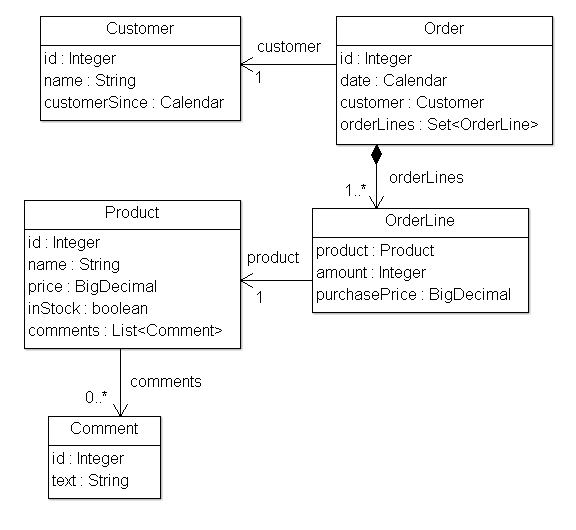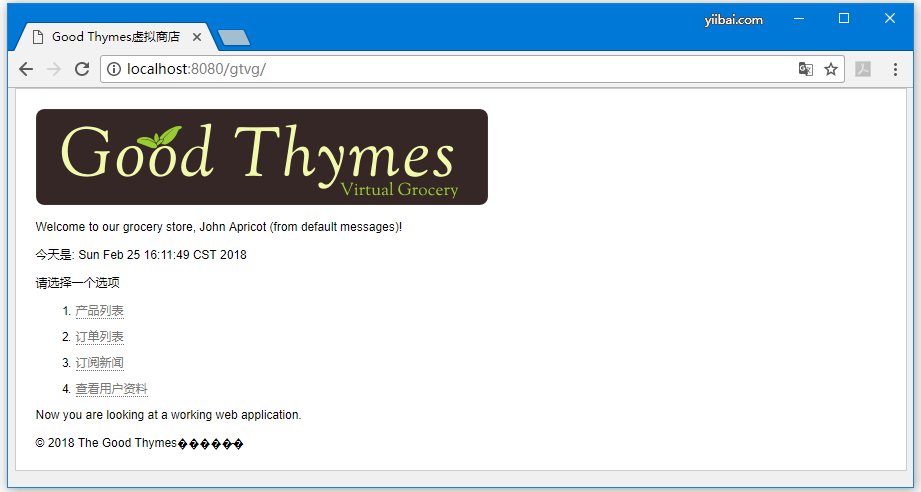Thymeleaf專案實踐
為了更好地解釋Thymeleaf處理模板所涉及的概念,本教學將使用一個演示應用程式,您可以下載本專案的應用程式。本專案是基於:Thymeleaf虛擬雜貨店 的漢化修改。
這個應用程式是一個虛擬的虛擬雜貨店的網站,並提供許多場景展示Thymeleaf的許多功能。
首先,我們需要為應用程式提供一組簡單的模型實體:銷售給客戶的產品有訂單資訊記錄。 也將管理對這些產品的注釋:
應用程式還將有一個非常簡單的服務層,由Service物件組成,其中包含以下方法:
/*
* =============================================================================
*
* Copyright (c) 2011-2016, The THYMELEAF team (http://www.thymeleaf.org)
*
* Licensed under the Apache License, Version 2.0 (the "License");
* you may not use this file except in compliance with the License.
* You may obtain a copy of the License at
*
* http://www.apache.org/licenses/LICENSE-2.0
*
* Unless required by applicable law or agreed to in writing, software
* distributed under the License is distributed on an "AS IS" BASIS,
* WITHOUT WARRANTIES OR CONDITIONS OF ANY KIND, either express or implied.
* See the License for the specific language governing permissions and
* limitations under the License.
*
* =============================================================================
*/
package com.yiibai.business.services;
import java.util.List;
import com.yiibai.business.entities.Product;
import com.yiibai.business.entities.repositories.ProductRepository;
public class ProductService {
public ProductService() {
super();
}
public List<Product> findAll() {
return ProductRepository.getInstance().findAll();
}
public Product findById(final Integer id) {
return ProductRepository.getInstance().findById(id);
}
}
在Web層,應用程式將有一個過濾器,根據請求URL將執行委託給啟用Thymeleaf的命令:
/*
* =============================================================================
*
* Copyright (c) 2011-2016, The THYMELEAF team (http://www.thymeleaf.org)
*
* Licensed under the Apache License, Version 2.0 (the "License");
* you may not use this file except in compliance with the License.
* You may obtain a copy of the License at
*
* http://www.apache.org/licenses/LICENSE-2.0
*
* Unless required by applicable law or agreed to in writing, software
* distributed under the License is distributed on an "AS IS" BASIS,
* WITHOUT WARRANTIES OR CONDITIONS OF ANY KIND, either express or implied.
* See the License for the specific language governing permissions and
* limitations under the License.
*
* =============================================================================
*/
package com.yiibai.web.filter;
import java.io.IOException;
import javax.servlet.Filter;
import javax.servlet.FilterChain;
import javax.servlet.FilterConfig;
import javax.servlet.ServletContext;
import javax.servlet.ServletException;
import javax.servlet.ServletRequest;
import javax.servlet.ServletResponse;
import javax.servlet.http.HttpServletRequest;
import javax.servlet.http.HttpServletResponse;
import org.thymeleaf.ITemplateEngine;
import com.yiibai.business.entities.User;
import com.yiibai.web.application.GTVGApplication;
import com.yiibai.web.controller.IGTVGController;
public class GTVGFilter implements Filter {
private ServletContext servletContext;
private GTVGApplication application;
public GTVGFilter() {
super();
}
private static void addUserToSession(final HttpServletRequest request) {
// Simulate a real user session by adding a user object
request.getSession(true).setAttribute("user", new User("John", "Apricot", "Antarctica", null));
}
public void init(final FilterConfig filterConfig) throws ServletException {
this.servletContext = filterConfig.getServletContext();
this.application = new GTVGApplication(this.servletContext);
}
public void doFilter(final ServletRequest request, final ServletResponse response,
final FilterChain chain) throws IOException, ServletException {
addUserToSession((HttpServletRequest)request);
if (!process((HttpServletRequest)request, (HttpServletResponse)response)) {
chain.doFilter(request, response);
}
}
public void destroy() {
// nothing to do
}
private boolean process(HttpServletRequest request, HttpServletResponse response)
throws ServletException {
try {
// This prevents triggering engine executions for resource URLs
if (request.getRequestURI().startsWith("/css") ||
request.getRequestURI().startsWith("/images") ||
request.getRequestURI().startsWith("/favicon")) {
return false;
}
/*
* Query controller/URL mapping and obtain the controller
* that will process the request. If no controller is available,
* return false and let other filters/servlets process the request.
*/
IGTVGController controller = this.application.resolveControllerForRequest(request);
if (controller == null) {
return false;
}
/*
* Obtain the TemplateEngine instance.
*/
ITemplateEngine templateEngine = this.application.getTemplateEngine();
/*
* Write the response headers
*/
response.setContentType("text/html;charset=UTF-8");
response.setHeader("Pragma", "no-cache");
response.setHeader("Cache-Control", "no-cache");
response.setDateHeader("Expires", 0);
/*
* Execute the controller and process view template,
* writing the results to the response writer.
*/
controller.process(
request, response, this.servletContext, templateEngine);
return true;
} catch (Exception e) {
try {
response.sendError(HttpServletResponse.SC_INTERNAL_SERVER_ERROR);
} catch (final IOException ignored) {
// Just ignore this
}
throw new ServletException(e);
}
}
}
下面是IGTVGController介面的程式碼:
/*
* =============================================================================
*
* Copyright (c) 2011-2016, The THYMELEAF team (http://www.thymeleaf.org)
*
* Licensed under the Apache License, Version 2.0 (the "License");
* you may not use this file except in compliance with the License.
* You may obtain a copy of the License at
*
* http://www.apache.org/licenses/LICENSE-2.0
*
* Unless required by applicable law or agreed to in writing, software
* distributed under the License is distributed on an "AS IS" BASIS,
* WITHOUT WARRANTIES OR CONDITIONS OF ANY KIND, either express or implied.
* See the License for the specific language governing permissions and
* limitations under the License.
*
* =============================================================================
*/
package com.yiibai.web.controller;
import javax.servlet.ServletContext;
import javax.servlet.http.HttpServletRequest;
import javax.servlet.http.HttpServletResponse;
import org.thymeleaf.ITemplateEngine;
public interface IGTVGController {
public void process(
HttpServletRequest request, HttpServletResponse response,
ServletContext servletContext, ITemplateEngine templateEngine)
throws Exception;
}
我們現在要做的就是建立IGTVGController介面的實現,從服務中檢索資料並使用ITemplateEngine物件處理模板。
最後,它會看起來得到類似下面的頁面:
但首先來看看這個模板引擎是如何初始化的。
建立和組態模板引擎
過濾器中的process(…)方法包含這一行:
ITemplateEngine templateEngine = this.application.getTemplateEngine();
GTVGApplication類負責建立和組態Thymeleaf應用程式中最重要的物件之一:TemplateEngine範例(實現ITemplateEngine介面)。org.thymeleaf.TemplateEngine物件是這樣初始化的:
public class GTVGApplication {
...
private final TemplateEngine templateEngine;
...
public GTVGApplication(final ServletContext servletContext) {
super();
ServletContextTemplateResolver templateResolver =
new ServletContextTemplateResolver(servletContext);
// HTML is the default mode, but we set it anyway for better understanding of code
templateResolver.setTemplateMode(TemplateMode.HTML);
// This will convert "home" to "/WEB-INF/templates/home.html"
templateResolver.setPrefix("/WEB-INF/templates/");
templateResolver.setSuffix(".html");
// Template cache TTL=1h. If not set, entries would be cached until expelled by LRU
templateResolver.setCacheTTLMs(Long.valueOf(3600000L));
// Cache is set to true by default. Set to false if you want templates to
// be automatically updated when modified.
templateResolver.setCacheable(true);
this.templateEngine = new TemplateEngine();
this.templateEngine.setTemplateResolver(templateResolver);
...
}
}
組態TemplateEngine物件的方法有很多種,但現在這幾行程式碼將足以教會需要的步驟。
模板解析器
從模板解析器開始:
ServletContextTemplateResolver templateResolver =
new ServletContextTemplateResolver(servletContext);
模板解析器是實現來自Thymeleaf API(名為org.thymeleaf.templateresolver.ITemplateResolver)的介面的物件:
public interface ITemplateResolver {
...
/*
* Templates are resolved by their name (or content) and also (optionally) their
* owner template in case we are trying to resolve a fragment for another template.
* Will return null if template cannot be handled by this template resolver.
*/
public TemplateResolution resolveTemplate(
final IEngineConfiguration configuration,
final String ownerTemplate, final String template,
final Map<String, Object> templateResolutionAttributes);
}
這些物件負責確定模板將如何被存取,並且在這個GTVG應用程式中,org.thymeleaf.templateresolver.ServletContextTemplateResolver意味著我們要從Servlet上下文中檢索我們的模板檔案作為資源:一個應用程式範圍的javax .servlet.ServletContext物件,它存在於每個Java Web應用程式中,並解析來自Web應用程式根目錄的資源。
但這並不是我們說的模板解析器,因為可以在其上設定一些組態引數。 首先,模板模式:
templateResolver.setTemplateMode(TemplateMode.HTML);
HTML是ServletContextTemplateResolver的預設模板模式,但最好還是建立它,以便可以清楚知道程式碼執行了什麼。
templateResolver.setPrefix("/WEB-INF/templates/");
templateResolver.setSuffix(".html");
字首和字尾修改了將傳遞給引擎以獲取要使用的真實資源名稱的模板名稱。
使用此組態,模板名稱「product/list」將對應於:
servletContext.getResourceAsStream("/WEB-INF/templates/product/list.html")
可選地,解析模板可以儲存在快取中的時間量是通過cacheTTLMs屬性在模板解析器中組態:
templateResolver.setCacheTTLMs(3600000L);
如果達到最大快取記憶體大小並且它是當前快取記憶體的最舊條目,則在達到TTL之前,模板仍可從快取記憶體中排除。
模板引擎
模板引擎物件是org.thymeleaf.ITemplateEngine介面的實現。 其中一個實現由Thymeleaf核心提供:org.thymeleaf.TemplateEngine,在這裡建立一個範例:
templateEngine = new TemplateEngine();
templateEngine.setTemplateResolver(templateResolver);
很簡單,不是嗎? 需要的只是建立一個範例並為其設定模板解析器。
模板解析器是TemplateEngine需要的唯一必需的引數,不過稍後還會介紹其他許多引數(訊息解析器,快取大小等)。
我們的模板引擎已準備就緒,就可以使用Thymeleaf開始建立頁面了。有關專案的程式碼,可以從: https://pan.baidu.com/s/1nwBa9Gd 下載。